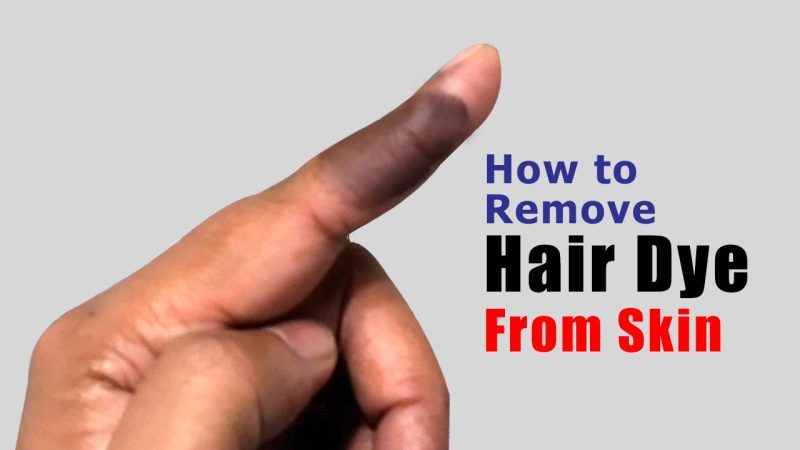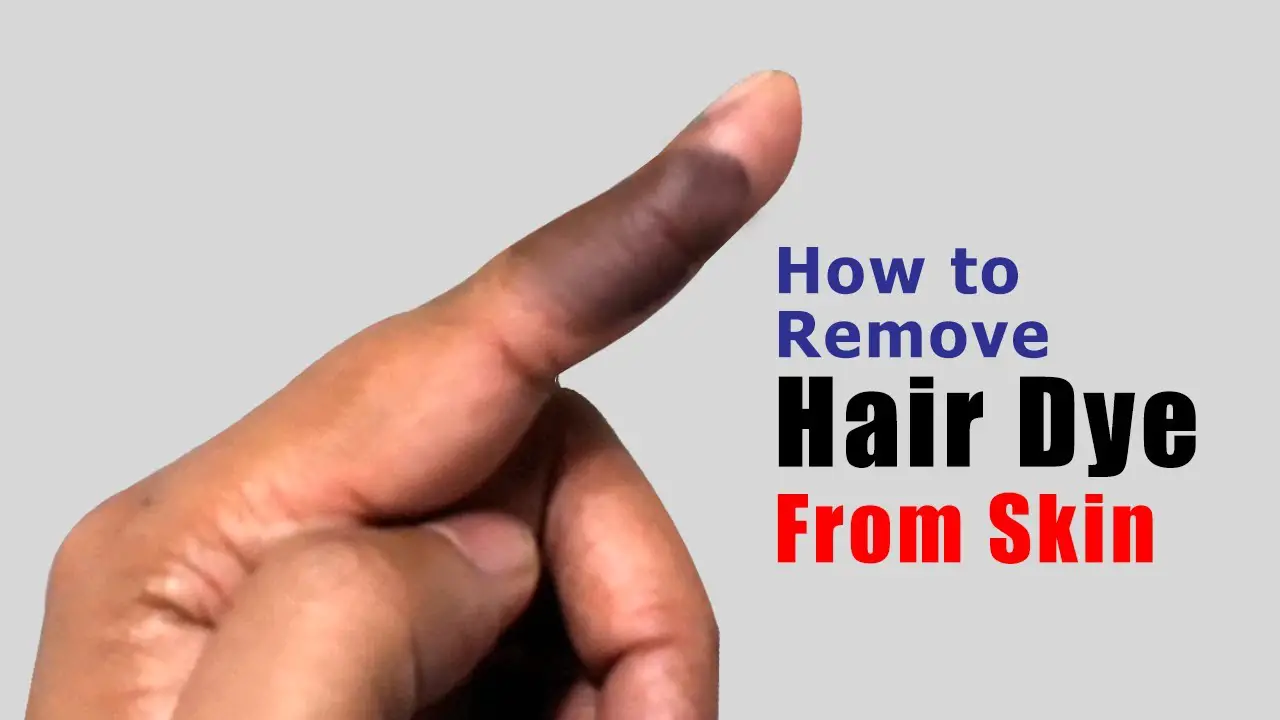Accidentally staining your skin while coloring your hair is something almost everyone experiences. Whether you’re a seasoned hair dye enthusiast or trying out a new look at home, those stubborn dye marks on your forehead, ears, and neck can be frustrating. Luckily, there are several safe and effective methods to remove hair dye stains without irritating your skin.
In this comprehensive guide, we’ll explore how to get hair dye off skin quickly and safely, using both household remedies and professional solutions. We’ll also discuss prevention tips, what not to do, and when to seek help if the stain persists.
Understanding Why Hair Dye Stains Skin

How Hair Dye Works
Hair dye penetrates the outer layer of the hair shaft to deposit pigment, but when it comes into contact with your skin, it can also tint the surface layer known as the epidermis. Since the skin absorbs the dye more easily in areas with thinner skin, such as around the hairline and neck, stains are common during the coloring process.
Why It’s Hard to Remove
Once dye molecules bond with the proteins and oils in your skin, the color becomes semi-permanent until the skin naturally exfoliates. This is why scrubbing too harshly can cause redness or irritation without completely removing the stain. The key is to lift the pigment gradually using gentle methods that dissolve or loosen the color molecules.
Preparation Before Removing Hair Dye
Before attempting to remove hair dye from your skin, it’s important to take a few precautionary steps:
-
Identify your skin type – If you have sensitive or dry skin, avoid alcohol-based or acidic products.
-
Test first – Always test any remover on a small patch of skin to avoid allergic reactions.
-
Use soft materials – Cotton pads or microfiber cloths work best; avoid abrasive scrubs or rough sponges.
-
Act quickly – The sooner you address the stain, the easier it is to remove.
Home Remedies to Get Hair Dye Off Skin Quickly
1. Baking Soda and Dish Soap
Baking soda is a natural exfoliant, and dish soap helps dissolve oily residues that may hold the dye in place. Together, they create a gentle but effective cleanser.
How to Use:
- Mix one tablespoon of baking soda with one tablespoon of dish soap.
- Apply the mixture to the stained area and massage gently in circular motions.
- Let it sit for one minute before rinsing with warm water.
Repeat once or twice if needed, but avoid over-scrubbing. This method works best on fresh stains.
2. Olive Oil or Coconut Oil
If you prefer a more natural solution, oils are excellent for breaking down pigment without harming your skin. They also moisturize and restore the skin barrier after dye removal.
How to Use:
- Apply a generous amount of olive or coconut oil to the stained area.
- Gently massage and leave it on for several hours or overnight.
- In the morning, wipe it off with a warm, damp cloth.
Oils are safe for all skin types and particularly beneficial for people with dry or sensitive skin.
3. Toothpaste (Non-Gel Type)
Toothpaste contains mild abrasives and cleansing agents that can help fade dye stains. The non-gel type works best since it doesn’t contain harsh coloring agents.
How to Use:
- Apply a small amount of toothpaste to the stained skin.
- Rub gently with a cotton pad or soft cloth for 1–2 minutes.
- Rinse with warm water and pat dry.
Avoid using whitening toothpaste, as it can irritate sensitive skin.
4. Makeup Remover or Micellar Water
If the stain is light or fresh, your regular makeup remover or micellar water can help. These products are formulated to lift pigments and oils gently from the skin.
How to Use:
- Soak a cotton pad in micellar water or makeup remover.
- Press it onto the stained area for about 30 seconds.
- Wipe in circular motions until the stain lightens.
This method is particularly safe for the face and neck.
5. Hydrogen Peroxide Solution
Hydrogen peroxide works as a mild bleaching agent that can break down dye pigments on the skin. However, it should be used cautiously.
How to Use:
- Mix equal parts of hydrogen peroxide (3%) and water.
- Dab the solution onto the stain with a cotton pad.
- Leave it for 2–3 minutes, then rinse thoroughly.
Avoid using this method near your eyes or on broken skin.
6. Rubbing Alcohol or Hand Sanitizer
Alcohol-based products dissolve hair dye pigments effectively, but they can also dry out the skin. Use them sparingly.
How to Use:
- Apply a small amount of rubbing alcohol or hand sanitizer to a cotton pad.
- Rub gently over the stained skin for 30 seconds.
- Rinse with warm water and apply moisturizer immediately after.
This works best for dye on the hands, ears, or neck, but not on sensitive facial skin.
7. Baking Soda and Lemon Juice
The combination of baking soda’s exfoliating power and lemon’s natural acidity can help lighten dark stains.
How to Use:
- Mix one teaspoon of baking soda with a few drops of lemon juice to form a paste.
- Apply it gently to the stained skin.
- Rub lightly, leave for one minute, and rinse off with water.
This method should be used only once to avoid irritation, especially if you have dry or sensitive skin.
Professional and Store-Bought Solutions
1. Hair Color Remover Wipes
These are pre-moistened wipes specifically designed to remove hair dye from skin safely. They contain mild cleansers that dissolve color pigments.
How to Use:
- Gently rub the wipe on the stained area in circular motions.
- Continue until the color fades.
They’re convenient, travel-friendly, and safe for daily use.
Hair Color Stain Remover Creams
Professional hair dye brands often produce their own stain-remover creams, commonly used in salons.
How to Use:
- Apply a small amount of the product to the stained area using a cotton pad.
- Massage gently for a few minutes.
- Wipe clean with a damp cloth.
Always follow the manufacturer’s directions to avoid skin irritation.
Clarifying Shampoo
Clarifying shampoos are formulated to remove buildup and can also lift light dye stains from the skin.
How to Use:
- Apply a small amount to the stained skin.
- Massage gently for 30 seconds.
- Rinse thoroughly and moisturize afterward.
This method is mild and safe, especially for dye around the hairline.
How to Get Hair Dye Off Hands and Nails
Your hands and nails are often the first to get stained during a home dye job. Here’s how to tackle those spots effectively.
1. Use a Nail Brush and Soap
Scrubbing gently with a nail brush and warm, soapy water helps remove stains trapped around the nails and cuticles.
2. Try Baking Soda Paste
A thick paste of baking soda and water can gently exfoliate the skin on your fingers and palms, removing pigment buildup.
3. Use Toothpaste for Fingertips
Rub a small amount of non-gel toothpaste on your fingertips and around your nails, then rinse after one minute for quick results.
How to Remove Hair Dye from Face and Neck
The skin on your face and neck is more sensitive, so it’s important to choose gentle methods.
1. Use Baby Oil or Petroleum Jelly
Massage baby oil or petroleum jelly onto the stained area and leave it for an hour. Wipe gently with a soft cloth. These products dissolve pigment without irritation.
2. Apply Micellar Water
Micellar water removes makeup and hair dye safely without harsh rubbing. Use it with cotton pads for best results.
3. Avoid Harsh Chemicals
Never use acetone, bleach, or concentrated alcohol on facial skin, as these can cause burns or severe dryness.
Prevention Tips to Avoid Hair Dye Stains
1. Create a Barrier Before Dyeing
Apply a thin layer of petroleum jelly or thick moisturizer around your hairline, ears, and neck before coloring your hair. This prevents the dye from sticking to your skin.
2. Wear Gloves
Always wear gloves, even when touching up small areas. This helps prevent stubborn stains on your hands and nails.
3. Wipe Spills Immediately
Keep a damp towel or baby wipe handy during the dyeing process. Clean any drips or smudges as soon as they occur to avoid deep staining.
4. Use a Tint Brush
Applying dye with a tint brush instead of your hands offers better precision and reduces mess around the skin.
What Not to Do When Removing Hair Dye from Skin
1. Don’t Scrub Too Hard
Scrubbing aggressively may cause redness, irritation, and peeling. The goal is to fade the stain gradually.
2. Avoid Strong Chemicals
Avoid nail polish remover, acetone, or bleach on your skin. These may remove the stain but can also burn or damage your skin barrier.
3. Don’t Mix Multiple Remedies
Using too many removal methods at once can cause chemical reactions or dryness. Stick to one method, and wait before trying another.
When to Seek Professional Help
If you experience pain, swelling, or burning sensations after trying at-home methods, stop immediately and consult a dermatologist. Persistent stains that don’t fade after several days may require professional skin-safe treatments.
Salon professionals also use specialized stain removers that can safely remove dye without harming your skin’s natural oils.
How Long Does It Take for Hair Dye to Fade from Skin Naturally?
Even without any treatment, most hair dye stains will fade on their own within three to seven days as your skin naturally sheds dead cells. You can speed up this process with gentle exfoliation and daily moisturizing.
However, darker dyes—such as black, brown, or red—tend to last longer and may require targeted removal techniques.
Natural Exfoliation Routine After Dye Removal
To help your skin recover and maintain smoothness after using any removal method, follow a gentle exfoliation and hydration routine.
Step 1: Cleanse
Use a mild facial or body cleanser to remove residual product.
Step 2: Exfoliate
Use a soft exfoliating scrub made from sugar and honey once daily for a few days.
Step 3: Moisturize
Apply aloe vera gel, shea butter, or a gentle moisturizer to soothe the skin.
H2: Frequently Asked Questions (FAQs)
1. Can I use nail polish remover to get hair dye off skin?
It’s not recommended. While acetone can dissolve dye pigments, it’s too harsh for the skin and can cause burns or dryness.
2. What’s the fastest way to remove hair dye from skin?
The quickest methods include using baking soda and dish soap or professional hair color remover wipes. Both work within minutes.
3. Does vinegar remove hair dye from skin?
Yes, diluted white vinegar can help fade stains, but it may cause mild irritation. Always mix it with water before applying.
4. Is it safe to use hydrogen peroxide on my face?
Use caution. Only apply diluted 3% hydrogen peroxide and rinse quickly. Avoid sensitive areas near the eyes.
5. Can I prevent staining during home hair coloring?
Yes, by applying petroleum jelly or thick moisturizer along your hairline and wearing gloves, you can significantly reduce staining.
Conclusion
Learning how to get hair dye off skin quickly and safely doesn’t have to be complicated. Whether you prefer gentle natural remedies like olive oil and baking soda or salon-grade removers, there’s a solution for every skin type. Acting fast, choosing the right method, and caring for your skin afterward will ensure a smooth, stain-free finish every time you color your hair.
With a little preparation and care, you can enjoy vibrant new hair color without worrying about unwanted skin stains.



